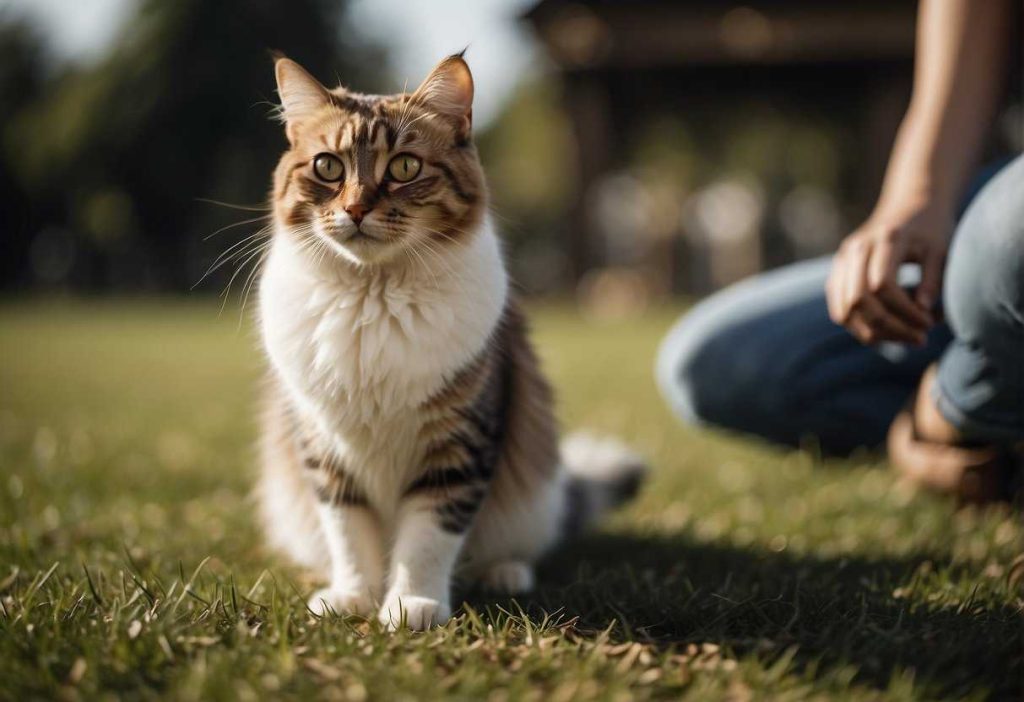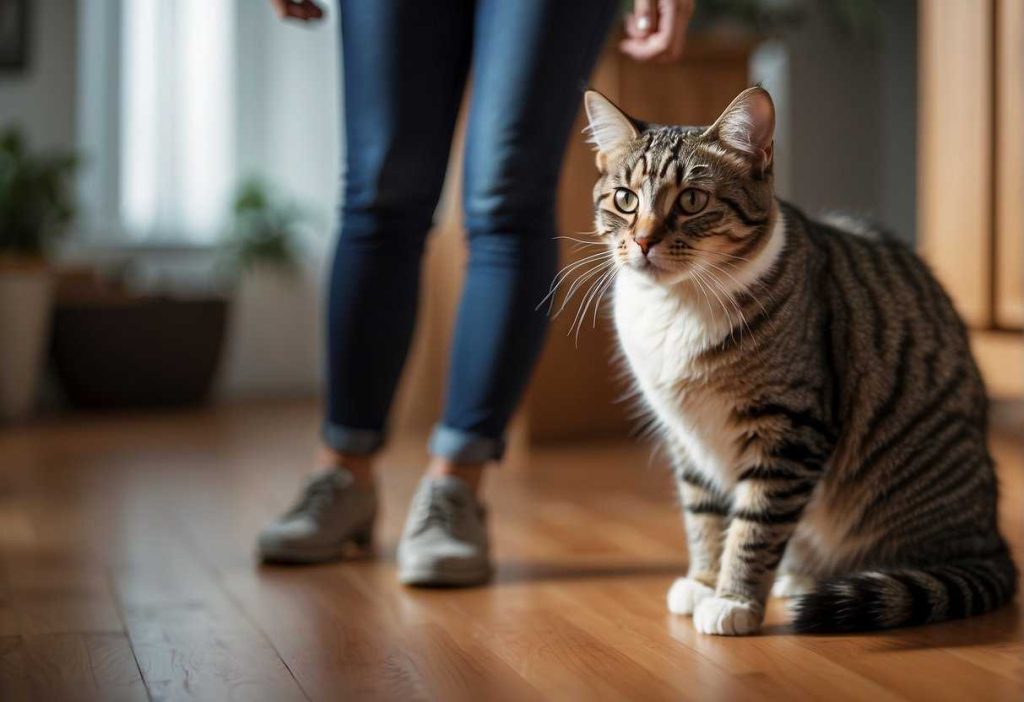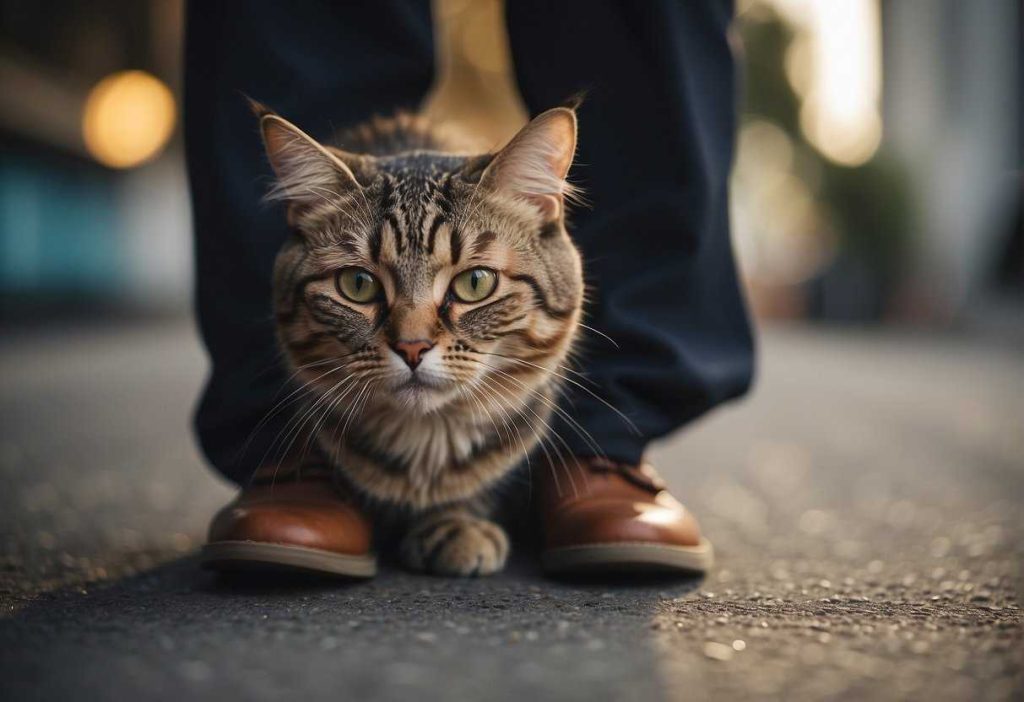Cat owners know that their feline friends are known for their independence, which can make a sudden burst of clinginess seem quite puzzling.
Have you noticed your cat seeking more affection than usual or following you around like a little shadow?
It’s not uncommon for cats to alter their behavior, and it can certainly be worrying when you notice these unexpected changes.

Understanding why your cat is suddenly sticking closer to you than Velcro can help ease your mind and ensure that their needs are met.
This article aims to shed light on the potential reasons behind your pet’s newfound neediness, offering practical advice to help you address this clingy behavior.
We’ll explore ways to strengthen your bond with your cat while also managing their clinginess effectively.
Key Takeaways
- Sudden clinginess in cats can indicate a change in their physical or emotional needs.
- Addressing clingy behavior involves observing your cat for other changes and potentially consulting a vet.
- Maintaining a strong bond with your cat while setting healthy boundaries can prevent future clinginess.
Why Is My Cat Suddenly Clingy: Understanding the Behavior
Cats can sometimes get a reputation for being independent creatures, but hey, they need cuddles too! Let’s explore what’s behind this sudden Velcro-like closeness.
Signs of a Clingy Cat:
- Following you around
- Excessive meowing or vocalization
- Constantly seeking your attention (1)
- Physical closeness, like sitting on your lap a lot (2)
Feeling watched? These behavioral changes can be cute but might leave you curious or even concerned.
Common Causes for Sudden Clinginess
Several reasons could be pulling at your cat’s attachment strings. Let’s break them down:
Environmental changes:
- Maybe you moved to a new place, or perhaps there’s a new pet in the house?
- Cats thrive on routine, and the smallest alteration can throw them for a loop.
Health Issues
Health issues can also lead to increased clinginess. If you suspect something’s off, it’s a straight road to the vet. Better to be safe!
| Health Issue | Clinginess Trigger |
| Injury or Pain | Seeking comfort |
| Illness | Need for security |
Psychological factors
Cats, just like us, can feel the weight of emotional distress. (3)
Anxiety, a past traumatic experience, or just plain boredom can make your cat stick like glue.
So, what’s the scoop with your cat? Keep an eye on their behavior, and don’t hesitate to seek professional advice if you’re puzzled.
After all, a content cat means a peaceful life, right?
Addressing Clingy Behavior in Cats

Identify the Trigger
First things first:
- Figuring out why your cat has become clingy.
- Consider any recent changes in your home environment. (4)
- Think about any potential stressors like new pets, moving houses, or a change in your routine. (5)
Create a Comfort Zone
Make a safe space for your cat:
- Cozy bedding
- Calm atmosphere
- Favorite toys to self-soothe
Consistent Routine
Cats love predictability. A steady routine reassures your furry friend. This includes:
- Regular feeding times (6)
- Scheduled play sessions
- Consistent cuddle moments
Attention and Affection
Make time for one-on-one:
- Bond through play. Maybe chase a laser dot together?
- Extra pets or grooming can be comforting.
Health Check
Sometimes clinginess is a health red flag.
- Observe for any signs of illness.
- Visit the vet if anything seems off.
- Regular check-ups can prevent problems.
Professional Help
If your DIY tricks aren’t doing the trick:
- Seek a vet’s or cat behaviorist’s advice.
- Remember, experts are like cat whisperers; they spot issues we might miss.
When to Worry
Most clinginess is no big deal, but keep an eye out for:
- Drastic changes in behavior. (7)
- Signs of anxiety or depression.
- Any symptoms of illness.
Addressing clinginess is about balance and understanding.
Each cat’s a unique puzzle, but with a bit of detective work, you’ll have the clinginess cracked in no time. Ready to be a super sleuth for your clingy companion?
Strengthening Your Bond While Managing Clinginess

Set a routine for playtime and cuddles:
- Cats love predictability. Establish regular times for affection and play – your cat will learn to look forward to these moments without feeling the need to be glued to you 24/7.
- Morning: 15 minutes of interactive play with toys
- Evening: 10 minutes of cuddle time
Interactive Toys:
- Give your cat toys that simulate hunting. This encourages natural behavior and allows for solo fun. (8)
- Feather wands
- Laser pointers
- Motorized mice
Encourage exploration and provide a stimulating environment. Cat trees, scratching posts, and window perches can offer entertainment and comfort when you’re not around.
Training and Treats:
- Train your cat to respond to their name or to perform simple tricks. Use treats as a reward, but don’t overdo it!
- Sit
- High-five
- Come when called
Personal Space:
- Provide a cozy cat bed in a quiet corner
- Use Feliway diffusers to create a calming atmosphere
Remember, your cat’s clinginess may also be a sign of underlying issues. If this behavior is new or has increased suddenly, a vet visit could rule out any health concerns.
In essence, the trick is to be there for your cat without being their only source of happiness.
By balancing love with healthy boundaries, you’ll foster a confident, happy, and semi-independent feline friend.
Expert Insights into Clingy Behavior

It’s not just for extra snacks! Veterinary behaviorists often point to a few common reasons behind your cat’s newfound clinginess. Let’s dig in!
- Health check: First things first, rule out health issues. A clingy cat can signal something’s up. If they’re suddenly sticking to you like glue, a vet visit is a wise move.
- Routine shifts: Cats are creatures of habit. Changes in your daily schedule, moving house, or even a new pet can lead to your cat seeking comfort and reassurance from you.
- Breed traits: Sure, some cat breeds are naturally more attached than others. Your Siamese or Burmese might just be living up to their sociable reputation!
Here’s a snapshot of how different factors contribute to clingy behavior:
| Factor | Impact on Clinginess |
| Health Issues | Can increase clinginess |
| Environmental Changes | Often leads to clinginess |
| Breed Specific Traits | May naturally impact behavior |
Remember, age matters too. Kittens and senior cats might crave more of your attention.
And if you’ve got a special-needs cat, they might depend on you for more than just cuddles. So, think about it: any big changes or health concerns popping up recently?
Your cat might just be responding to these. Keep observing and chatting with your vet, because hey, isn’t solving the mystery part of the fun?
Besides, scratching below the surface of your cat’s behavior can bring you even closer – literally!
Preventing Future Clinginess

Strengthen Their Independence:
- Create an enriching environment. Make sure you’ve got plenty of toys around to keep your cat entertained when you’re not home.
- Encourage playtime. Spend quality time playing with your cat.
- It helps them drain energy and reduces anxiety.
Routine is Key:
- Try to feed, play, and give attention at regular times each day.
- Cats are creatures of habit and thrive on routine.
Limit Over-Coddling:
- It’s tempting to constantly hold and cuddle your cute cat, but try to resist.
- Balancing cuddles with space teaches them to be alone.
Health Checks:
- A sudden behavior change might indicate a health issue.
- Regular vet check-ups can prevent problems from developing.
Safe Spaces:
- Provide a personal haven. A cozy bed or a perch by the window can be a private retreat for your kitty.
Remember, it’s not about ignoring your cat’s needs; rather, it’s about promoting behaviors that lead to a well-adjusted and confident pet.
Keep these tips in mind, and your cat will likely be the perfect mix of loving and independent.
Additional Considerations for Cat Owners

Feeding Time:
Cat parents, are you filling your cat’s bowl with the good stuff? A balanced diet is vital for a happy, healthy cat.
- Wet Food vs. Dry Food: Mix it up to provide hydration and crunch.
- Timely Meals: Keep a regular feeding schedule to prevent anxiety.
Playtime and Exercise:
Is your cat bouncing off the walls or snuggling excessively?
- Daily Play: Engage in at least 20-30 minutes of active play.
- Toys: Variety is the spice of life – the same goes for toys!
Health Checks:
- Vet Visits: Yearly check-ups are a must. When did you last visit the vet?
- Weight Watch: Keep an eye on their weight for any sudden changes.
Comfort and Security:
Does your cat have a cozy spot to call their own?
- Beds & Hideaways: Ensure they have a quiet place to retreat.
Companionship:
Sometimes, they just need a friend – could it be you or possibly a new fur sibling?
- Quality Time: Daily cuddles and calm can go a long way.
- Another Pet: Consider the dynamics before bringing in a new buddy.
Keep this checklist handy, and you’ll be on track for elevating your cat’s mood and health. Who knows, they might just thank you with some extra purrs and less velcro-like behavior!
Remember, a happy cat means a happy lap – so stay attentive and loving, and you’ll both feel the benefits.
Quick Recap

Cats are notoriously independent creatures, but sometimes they go through phases where they crave more attention and become extra clingy.
If you’re scratching your head wondering why, here’s a quick rundown to bring you up to speed:
Possible Reasons for Sudden Clinginess:
- Changes in Environment: Moving to a new house or even rearranging furniture can unsettle your cat.
- Health Issues: Cats might seek comfort from their owners if they’re feeling unwell.
- Anxiety or Stress: Noisy environments or the addition of a new pet or new family member can be stressful.
- Aging: Older cats sometimes want more companionship.
- Breed-Specific Tendencies: Some breeds naturally enjoy more human interaction.
What You Can Do:
- Visit the Vet: Rule out any potential health concerns.
- Provide a Safe Space: Make sure your cat has a cozy spot to retreat to.
- Consistent Routine: Keeping a regular schedule helps reduce feline stress.
- Play and Interaction: Dedicate time for play to help ease anxiety.
Frequently Asked Questions

When your kitty starts demanding more cuddles or won’t leave your side, it’s natural to wonder why.
This FAQ section covers common queries about your cat’s sudden need for extra attention, helping you understand and respond to your furry friend’s behavior.
What are the immediate steps I should take if my cat suddenly becomes clingy?
Check for any visible signs of distress or injury. Ensure that your cat’s environment is safe and that their basic needs for food, water, and comfort are being met.
If the clinginess persists, consider a visit to the veterinarian to rule out medical issues.
Could my cat’s sudden clinginess be a sign of illness?
Yes, sudden behavioral changes, like increased clinginess, can suggest your cat isn’t feeling well.
Clinginess can be associated with conditions ranging from pain to stress-related disorders.
If you’re concerned, a vet check-up can provide peace of mind and a health assessment.
How do I differentiate between my cat being affectionate and being clingy?
Affection is your cat showing love in a relaxed manner, often on their terms.
Clinginess, on the other hand, is more about seeking constant reassurance and being unable to stay calm when alone.
If your cat’s behavior seems driven by anxiety, it might be clinginess.
What role does anxiety play in my cat’s clingy behavior, and how can I help reduce it?
Anxiety can be a big factor in clingy behavior, originating from changes in surroundings, new pets, or even alterations in your routine.
Creating a calm environment and maintaining a consistent routine can help. If needed, a professional behaviorist can offer assistance.
Are certain cat breeds more prone to clinginess than others?
Indeed, breeds like Siamese and Burmese are known for their sociable and dependent nature, often seeking more attention than less sociable breeds.
Research the characteristics of your cat’s breed for a better understanding of their behavior.
Can changes in my routine affect my cat’s behavior and make them clingier?
Absolutely! Cats are creatures of habit and can become stressed or anxious when their daily routines are disrupted.
Your cat may become more clingy if they sense instability or anticipate further changes.
How can I gently discourage clingy behavior without causing my cat stress?
Gradually encouraging independence is key.
Provide stimulating toys for solo playtime and create inviting spaces where they can retreat and feel secure.
Acknowledge their clingy behavior with a calm and soothing voice but avoid reinforcing it with excessive attention.
- The Ultimate Overview to Actual Cash Gambling Establishments - July 1, 2025


